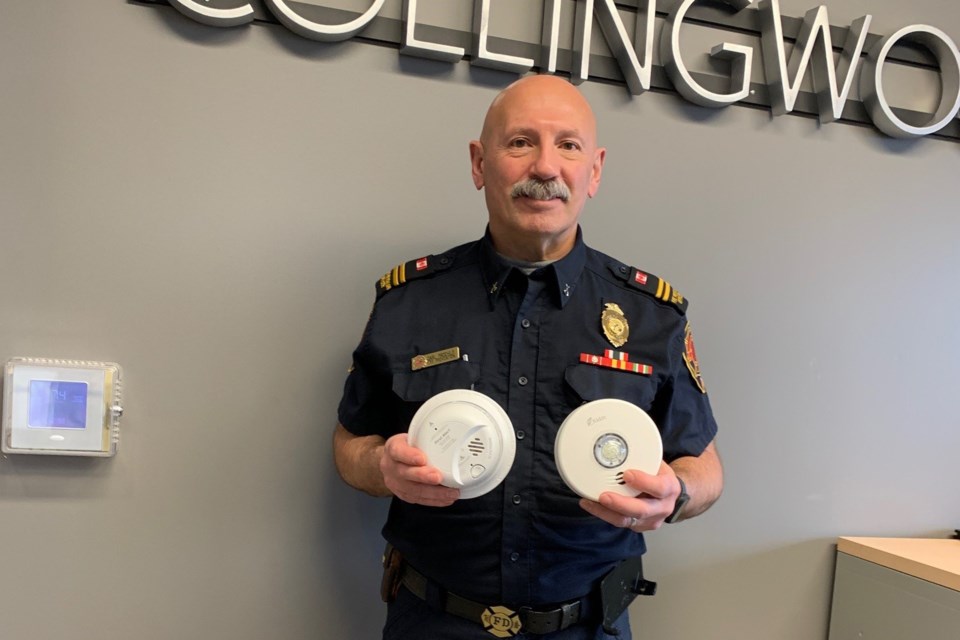Smoke and carbon monoxide (CO) alarms save lives, but they have to be installed and maintained properly to do that.
Collingwood Fire Department Fire Prevention Officer Carl Prochilo offers the following tips for making sure your family gets early warning from smoke and CO alarms.
“Smoke/CO Alarms save lives. When properly installed and maintained they play a vital role in early detection so you and your family can escape." said Prochilo. "If there is a fire in your home, smoke will spread fast, and you need smoke/CO alarms to give you time to get out….and stay out. Every second counts. Check your smoke/CO alarms monthly, make sure they are working properly. Protect yourself, your family, and your home.”
What is a combination alarm?
Combination smoke and carbon monoxide alarms have sensing technologies that work together to detect smoke, fire, and carbon monoxide. Some alarms may have audible features that will notify you differently depending on the hazard detected. Please read manufacturer instructions to understand the features of your alarm.
Where should I install my combination alarm?
Install smoke alarms inside each bedroom, outside each sleeping area and on every level of your home, including the basement.
On levels without bedrooms, install alarms in the living room (or den or family room) or near the stairway to the upper level, or in both locations.
Smoke alarms installed in the basement should be installed on the ceiling at the bottom of the stairs leading to the next level.
Smoke alarms should be installed at least three metres (10 feet) from a cooking appliance to minimize false alarms when cooking or from bathrooms with showers.
Mount smoke alarms high on walls or ceilings (remember, smoke rises). Wall-mounted alarms should be installed not more than 12 inches away from the ceiling (to the bottom of the alarm).
Don't install smoke alarms near windows, doors, ceiling fans or ducts where drafts might interfere with their operation.
Never paint smoke alarms. Paint, stickers, or other decorations could keep the alarms from working.
For the best protection, interconnect all smoke alarms. When one smoke alarm sounds, they all sound. Interconnection can be done using hard-wiring or wireless technology.
When interconnected smoke alarms are installed, it is important that all the alarms are from the same manufacturer. If the alarms are not compatible, they may not sound.
There are two types of smoke alarms – ionization and photoelectric. An ionization smoke alarm is generally more responsive to flaming fires, and a photoelectric smoke alarm is generally more responsive to smoldering fires. For the best protection, both types of alarms or combination ionization-photoelectric alarms, also known as dual sensor smoke alarms, are recommended.
Keep manufacturer’s instructions for reference.
When should I clean my alarm?
It is very important to clean your alarm regularly by gently vacuuming the outside of the alarm to remove dust build-up. At minimum, clean your alarms when you change your clocks in the spring and fall. This could reduce nuisance alarms.
When should I replace my alarms?
Generally, alarms should be replaced before the 10-year anniversary of the date of manufacture unless a replacement date is identified on the alarm label. If no manufacture date can be found the alarm should be replaced immediately.
If an alarm is damaged, painted, not functioning, or is involved in a fire or heavy smoke condition it should be replaced immediately.
Why is my alarm chirping?
The “chirp” is usually caused by issues related to the battery. As the battery in a smoke alarm becomes weak, the smoke alarm will "chirp" about once a minute to alert you that the battery needs to be replaced.
Only the alarm with a low battery will chirp. No signal is sent through the interconnect wire. The other alarms will be silent. If the “chirp” is every 30 seconds, then it’s time to replace the alarm. Please refer to the manufacturer instructions and after troubleshooting if the chirping is not resolved contact your local fire department.
For more fire safety tips or if you have any questions, please contact Collingwood Fire Department at 705-445-3920.



